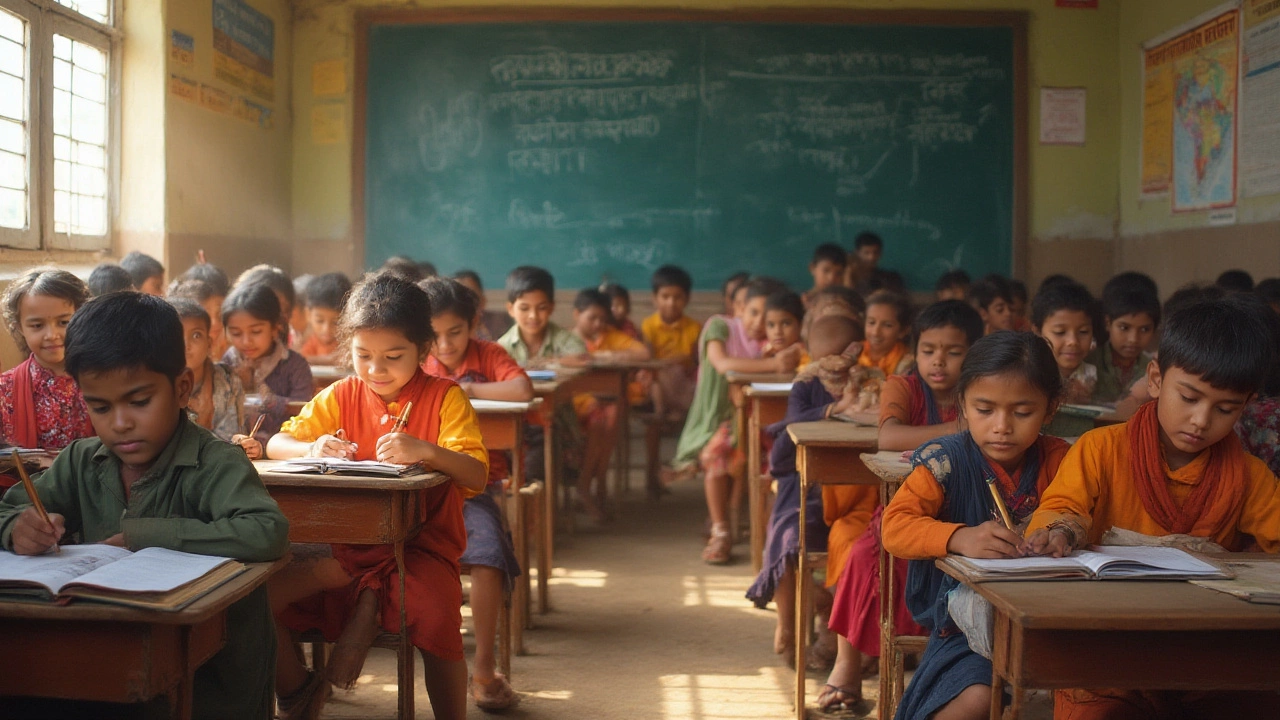Picture this: you walk down a busy street in Bangalore, and every second person you meet talks about engineering, medicine, or scoring well in an exam. You see startup founders, science prodigies, and kids sharpening their coding skills before they even reach high school. The vibe often feels like India’s churning out graduates and innovators in every direction. But does this mean India is actually the most educated country on the planet? Let’s break it all down—without sugarcoating the facts, and with a close look at what the numbers, realities, and everyday experience really say.
India's Education in Numbers: Crunching the Stats
Start with what’s measurable: India’s literacy rate. According to the National Statistical Office survey in 2023, India’s literacy rate sits at about 77.7%. That’s a solid climb from decades past—it was only about 52% in 1991. But here’s the kicker: global leaders like Finland, Norway, and Japan boast literacy rates of nearly 100% among their adult populations. China claims about 97% as of 2024. The U.S. hovers around 99%. So, India isn’t at the very top, but it’s made impressive strides in a relatively short time.
But literacy rate isn’t everything. College graduation matters, too. India produces the largest number of engineers globally—more than 1.5 million each year (think NIRF and All India Council for Technical Education data). The country cranks out millions of new graduates in commerce, science, and humanities fields annually. India’s a global leader in sending students for international studies as well: the Ministry of Education’s recent reports say there were more than 1.3 million Indian students enrolled in foreign universities in 2024. That’s more than any other country, except China.
Dig into school enrollment and completion rates, and things get more layered. Universal primary education is nearly reality in Indian cities, but rural dropout rates still worry experts. According to recent data from UNICEF, around 25% of Indian children drop out before finishing high school. The reasons? Poverty, family pressure, access to quality schools—especially for girls and marginalized groups.
| Country | Literacy Rate (%) | Higher Education Graduates (2024, est.) |
|---|---|---|
| India | 77.7 | ~8 million/year |
| Finland | 100 | ~100,000/year |
| China | 97 | ~10.6 million/year |
| USA | 99 | ~3.9 million/year |
Quality matters as much as quantity. India is home to world-class institutions like IITs, IIMs, AIIMS, and a few internationally top-ranked universities. Still, the majority of universities don’t crack the global top 200 lists. The National Institutional Ranking Framework (NIRF) helps, but big disparities persist in the actual learning outcomes between rural and urban, public and private schools. The World Bank’s Learning Poverty Index from 2023 shows that 55% of Indian children at age 10 still struggle to read and understand a simple story in their language. That’s changing, especially in metros, but it’s not there yet.
The numbers tell one story. The daily reality tells another. So where does that leave the big question?
The Global Comparison: How Does India Stack Up?
So, is India the most educated country? By some counts, it leads the world in volume—more students, more graduates, more applicants to higher education than almost anywhere else. Every year, several Indian students ace global Olympiads in math, science, and coding. But let’s zoom out and compare apples to apples.
If we judge by literacy and educational attainment (like high school and university completion), countries like Canada, Japan, Norway, and South Korea consistently score higher. Canada’s not just at 99% literacy; it also has the highest percentage of college graduates—over 56% of its adult population hold a degree. South Korea and Singapore stand out for topping the Programme for International Student Assessment (PISA) tests, which measure reading, math, and science skills among 15-year-olds worldwide. India hasn’t consistently participated in PISA; the first major group participation happened in 2022 after a decade-long gap, with mixed results placing India below the OECD average in both math and reading.
Access is part of the story. India has expanded its educational infrastructure at blazing speeds, building nearly 1.6 million schools and over 45,000 colleges. Compare that to Finland, which has around 3,500 schools—small in number, but almost all rank as world leaders in teacher training, student wellbeing, and holistic skill development. In Finland and Japan, the whole system puts less focus on rote memorization and more on creativity, collaboration, and mental health.
One strength for India, though, is the sheer willpower of its student body. Go to a coaching class in Kota or a training center in Hyderabad, and you’ll see thousands of young people burning the midnight oil to make it to IIT, AIIMS, or the civil services. The hunger to succeed and the competition are legendary. Indian parents invest a chunk of their savings in their kids’ private tuitions, test prep, and international study plans. That’s why Indian students win spelling bees, math contests, and land top jobs in tech and medicine abroad.
But while India’s top students are truly world-beaters, the system struggles with inclusivity and consistency. While the metropolitan elite enjoy access to international-level schools, millions in remote villages still rely on underfunded, crowded classrooms. The government’s recent push with the New Education Policy (NEP 2020) aims to change that, with code skills from early grades, mother-tongue learning up to Class 5, and a focus on critical thinking over rote. But changing a country this big doesn’t happen overnight.
So, globally, India ranks as a potential superpower of education, but it’s not numero uno—yet. The drive is there; bridging gaps is the challenge.

Strengths and Struggles of the Indian Education System
Peek under the hood, and India’s education engine is both impressive and flawed. For one thing, there’s access: more kids are in school than ever before, and girls’ enrollment has skyrocketed. The Right to Education Act (RTE), rolled out in 2009, made primary school free and compulsory—a massive move for a country where education wasn’t always a given for every child.
Another win? India is a magnet for global edtech. Startups like BYJU’S and Unacademy have put online learning into the hands of families everywhere, sometimes even where physical classrooms can’t reach. During the COVID-19 lockdowns, this became lifelines for millions. Clever use of WhatsApp for health and education tips, offline TV classes, and digital courses have picked up where in-person learning left off. The digital divide is still real; about 55% of Indian households lack regular internet, according to TRAI 2024 reports, but the trend line is positive.
Yet, quality remains stubbornly variable. It’s possible to meet kids who can recite Shakespeare in posh Delhi English-medium schools, while children in many government schools still face teacher shortages, outdated textbooks, and crumbling infrastructure. The recruitment of well-trained teachers can lag, especially in rural districts. Government watchdogs point to ghost schools—officially open but practically empty. Then there’s the shadow education industry: private tuitions and test prep centers soak up a huge share of parental spending, reportedly around $13 billion a year nationally as of 2022.
For those who do make it to university, placement is another headache. Only a fraction of graduates land jobs that match their qualifications, and employers often grumble about the lack of practical or soft skills. The 2023 India Skills Report showed that only around 50% of Indian graduates were considered employable by recruiters—much of it due to communication gaps and not enough real-world exposure.
The good? Indian graduates are everywhere. You see them running multinational companies, heading major hospitals, cracking the world’s most competitive exams, and launching startups not just at home, but from Silicon Valley to Singapore. The global demand for Indian talent is real—especially in STEM fields, finance, and medicine—thanks to the country’s epic focus on technical education.
But the pressure? It’s intense. Teens in India juggle relentless exam schedules that can last for months. Depression and anxiety among students are major issues, according to the Indian Psychiatry Society, with up to 20% of students reporting high levels of mental stress during high-stakes tests.
Indian education is a paradox: ambitious, persistent, expanding rapidly—but still deeply unequal. That’s the reality on the ground, and fixing it means more reform, better funding, and a focus on well-being—the stuff that makes the world’s classrooms leaders for more than just numbers.
Tips from India’s Experience: What Works and What’s Next?
If any country’s school system is worth watching for its sheer scale of ambition, it’s India. While it’s not yet the world’s most educated nation, there’s a lot to learn from its journey. If you’re a parent, educator, or policymaker anywhere, a few takeaways stand out.
- India education system shows that access is only the first step. You’ve got to link it to real skills, up-to-date teaching, and mental health support. Education reforms should never stop at enrollment—they need to address outcomes.
- Experiment with edtech—but don’t abandon the basics. India’s online learning explosion kept millions in school during the toughest times, but nothing replaces a motivated, trained teacher and a solid classroom community.
- Mental health is as critical as math and science. When pressure mounts from non-stop exams and expectations, helping students manage stress makes a difference for learning and life beyond school. Schools and families can start with simple check-ins, professional counseling, and regular breaks.
- Don’t be shy about skill-based education. Vocational training, coding classes for kids, and internships tied to real industry jobs can bridge the massive gap between what’s taught in class and what’s needed at work. India is rolling out coding from early grades, and results look promising—especially in tech-forward cities.
- Push for inclusive growth. The best parts of India’s system show it’s possible to boost both boys’ and girls’ education, and bring new groups into the fold. Scholarships, midday meals, and free textbooks aren’t just perks—they change futures.
- Measure success by more than just board exam scores. Critical thinking, team projects, and passion-driven learning create innovators and leaders, not just rank holders. Borrow a page from Finland or Japan: less rote work, more real-life learning.
As for what’s next: keep an eye on the rollout of the New Education Policy, focus on teacher training (which makes a bigger classroom difference than any shiny exam result), and look for ways to shrink the gap between city and rural schools. India’s not the world leader in education yet, but with relentless ambition, adaptation, and social investment, it’s gunning for the top spots. The real edge? A culture that never stops learning, hustling, and dreaming big. That’s something any country would do well to copy.
